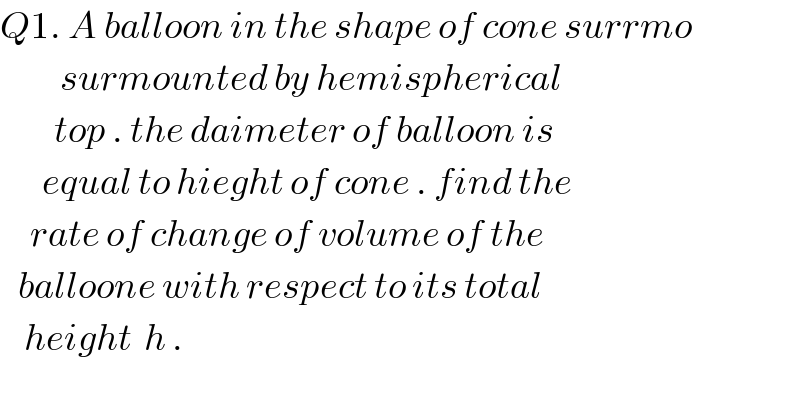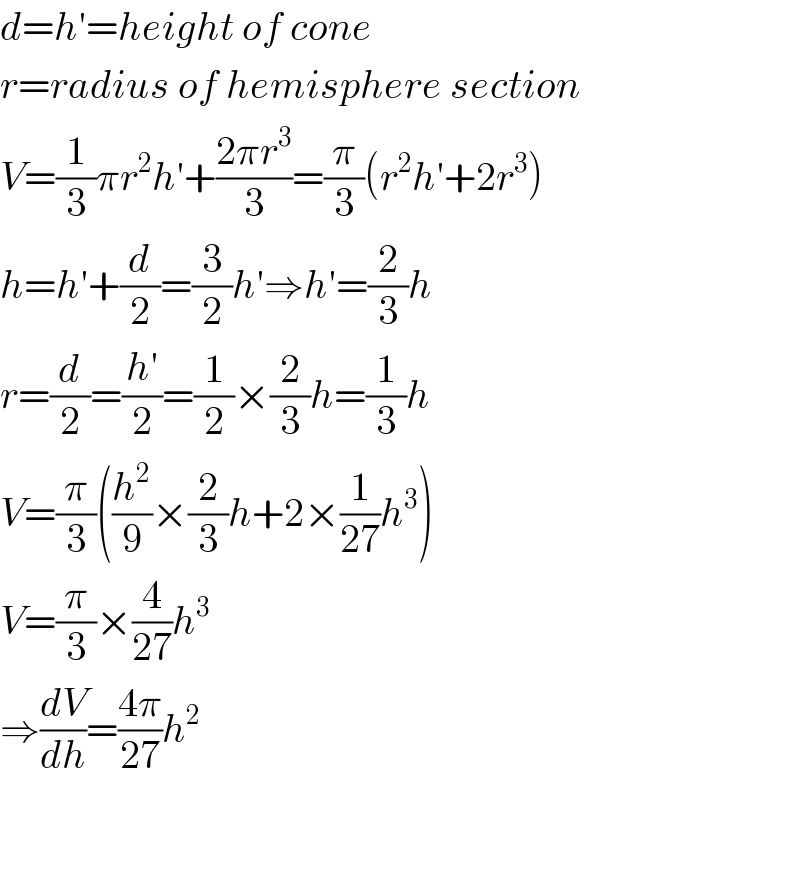
Question Number 7265 by 2402@gmail.com last updated on 20/Aug/16

$${Q}\mathrm{1}.\:{A}\:{balloon}\:{in}\:{the}\:{shape}\:{of}\:{cone}\:{surrmo} \\ $$$$\:\:\:\:\:\:\:\:\:\:{surmounted}\:{by}\:{hemispherical} \\ $$$$\:\:\:\:\:\:\:\:\:{top}\:.\:{the}\:{daimeter}\:{of}\:{balloon}\:{is} \\ $$$$\:\:\:\:\:\:\:{equal}\:{to}\:{hieght}\:{of}\:{cone}\:.\:{find}\:{the} \\ $$$$\:\:\:\:\:{rate}\:{of}\:{change}\:{of}\:{volume}\:{of}\:{the} \\ $$$$\:\:\:{balloone}\:{with}\:{respect}\:{to}\:{its}\:{total} \\ $$$$\:\:\:\:{height}\:\:{h}\:. \\ $$
Commented by Yozzia last updated on 20/Aug/16

$${d}={h}'={height}\:{of}\:{cone} \\ $$$${r}={radius}\:{of}\:{hemisphere}\:{section} \\ $$$${V}=\frac{\mathrm{1}}{\mathrm{3}}\pi{r}^{\mathrm{2}} {h}'+\frac{\mathrm{2}\pi{r}^{\mathrm{3}} }{\mathrm{3}}=\frac{\pi}{\mathrm{3}}\left({r}^{\mathrm{2}} {h}'+\mathrm{2}{r}^{\mathrm{3}} \right) \\ $$$${h}={h}'+\frac{{d}}{\mathrm{2}}=\frac{\mathrm{3}}{\mathrm{2}}{h}'\Rightarrow{h}'=\frac{\mathrm{2}}{\mathrm{3}}{h} \\ $$$${r}=\frac{{d}}{\mathrm{2}}=\frac{{h}'}{\mathrm{2}}=\frac{\mathrm{1}}{\mathrm{2}}×\frac{\mathrm{2}}{\mathrm{3}}{h}=\frac{\mathrm{1}}{\mathrm{3}}{h} \\ $$$${V}=\frac{\pi}{\mathrm{3}}\left(\frac{{h}^{\mathrm{2}} }{\mathrm{9}}×\frac{\mathrm{2}}{\mathrm{3}}{h}+\mathrm{2}×\frac{\mathrm{1}}{\mathrm{27}}{h}^{\mathrm{3}} \right) \\ $$$${V}=\frac{\pi}{\mathrm{3}}×\frac{\mathrm{4}}{\mathrm{27}}{h}^{\mathrm{3}} \\ $$$$\Rightarrow\frac{{dV}}{{dh}}=\frac{\mathrm{4}\pi}{\mathrm{27}}{h}^{\mathrm{2}} \\ $$$$ \\ $$$$ \\ $$
